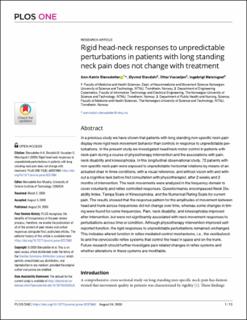| dc.contributor.author | Stensdotter, Ann-Katrin | |
| dc.contributor.author | Stavdahl, Øyvind | |
| dc.contributor.author | Vasseljen, Ottar | |
| dc.contributor.author | Meisingset, Ingebrigt | |
| dc.date.accessioned | 2020-11-04T08:59:46Z | |
| dc.date.available | 2020-11-04T08:59:46Z | |
| dc.date.created | 2020-09-02T08:42:52Z | |
| dc.date.issued | 2020 | |
| dc.identifier.citation | PLOS ONE. 2020, 15 (8), 1-12. | en_US |
| dc.identifier.issn | 1932-6203 | |
| dc.identifier.uri | https://hdl.handle.net/11250/2686295 | |
| dc.description.abstract | In a previous study we have shown that patients with long standing non-specific neck-pain display more rigid neck movement behavior than controls in response to unpredictable perturbations. In the present study we investigated head/neck motor control in patients with neck-pain during a course of physiotherapy intervention and the associations with pain, neck disability and kinesiophobia. In this longitudinal observational study, 72 patients with non-specific neck-pain were exposed to unpredictable horizontal rotations by means of an actuated chair in three conditions; with a visual reference, and without vision with and without a cognitive task before first consultation with physiotherapist, after 2 weeks and 2 months of intervention. The neck movements were analyzed in the frequency domain to cover voluntarily and reflex controlled responses. Questionnaires encompassed Neck Disability Index, Tampa Scale of Kinesiophobia, and the Numerical Rating Scale for current pain. The results showed that the response pattern for the amplitudes of movement between head and trunk across frequencies did not change over time, whereas some changes in timing were found for some frequencies. Pain, neck disability, and kinesiophobia improved after intervention, but were not significantly associated with neck movement responses to perturbations across time or condition. Although physiotherapy intervention improved self-reported function, the rigid responses to unpredictable perturbations remained unchanged. This indicates altered function in reflex mediated control mechanisms, i.e., the vestibulocollic and the cervicocollic reflex systems that control the head in space and on the trunk. Future research should further investigate pain related changes in reflex systems and whether alterations in these systems are modifiable. | en_US |
| dc.language.iso | eng | en_US |
| dc.publisher | Public Library of Science | en_US |
| dc.rights | Navngivelse 4.0 Internasjonal | * |
| dc.rights.uri | http://creativecommons.org/licenses/by/4.0/deed.no | * |
| dc.title | Rigid head-neck responses to unpredictable perturbations in patients with long standing neck pain does not change with treatment | en_US |
| dc.type | Peer reviewed | en_US |
| dc.type | Journal article | en_US |
| dc.description.version | publishedVersion | en_US |
| dc.source.pagenumber | 1-12 | en_US |
| dc.source.volume | 15 | en_US |
| dc.source.journal | PLOS ONE | en_US |
| dc.source.issue | 8 | en_US |
| dc.identifier.doi | https://doi.org/10.1371/journal.pone.0237860 | |
| dc.identifier.cristin | 1826626 | |
| dc.description.localcode | Copyright: © 2020 Stensdotter et al. This is an open access article distributed under the terms of the Creative Commons Attribution License, which permits unrestricted use, distribution, and reproduction in any medium, provided the original author and source are credited. | en_US |
| cristin.ispublished | true | |
| cristin.fulltext | original | |
| cristin.qualitycode | 1 | |

